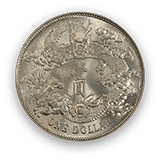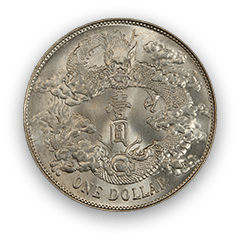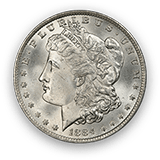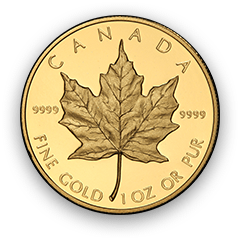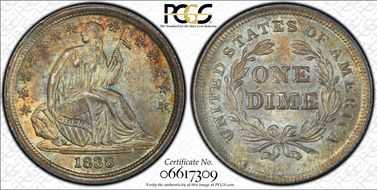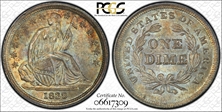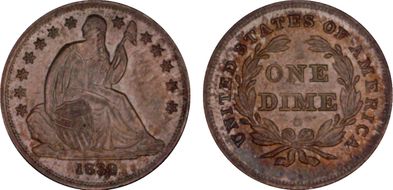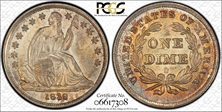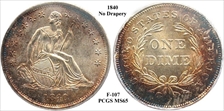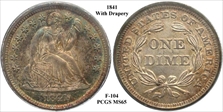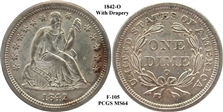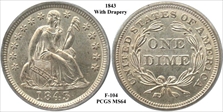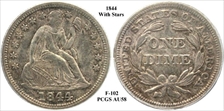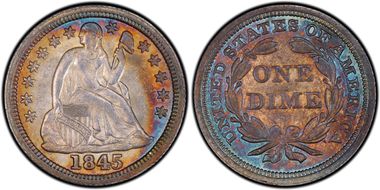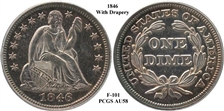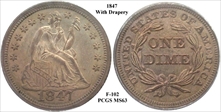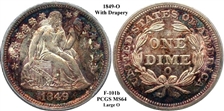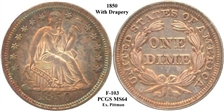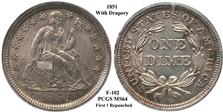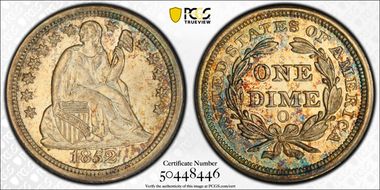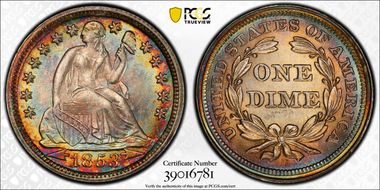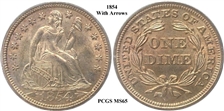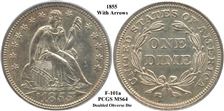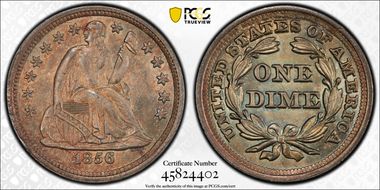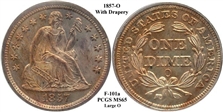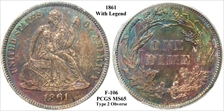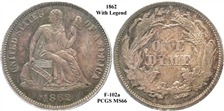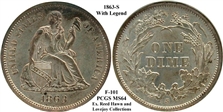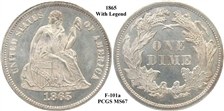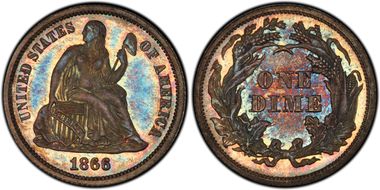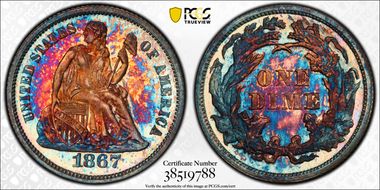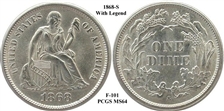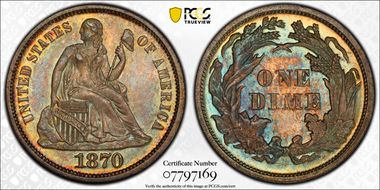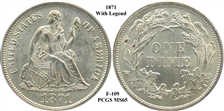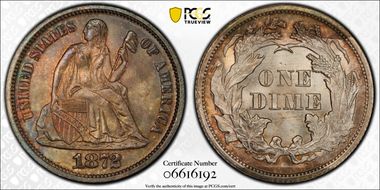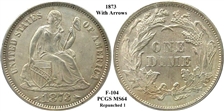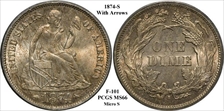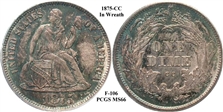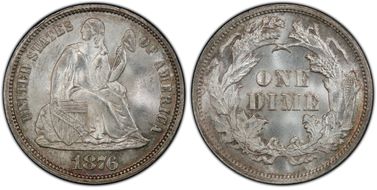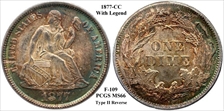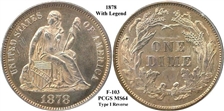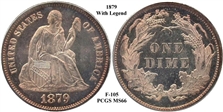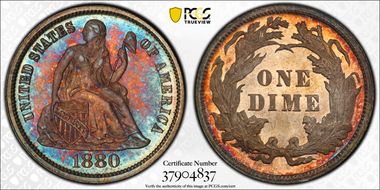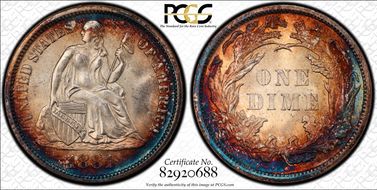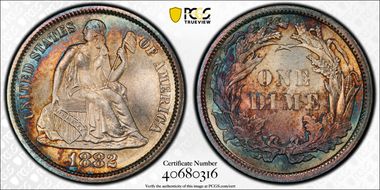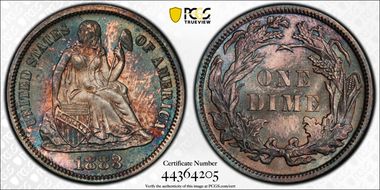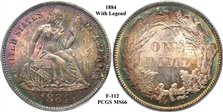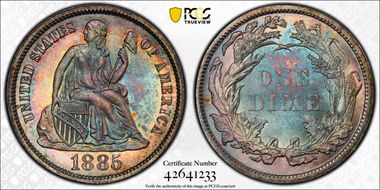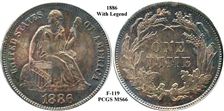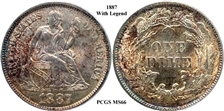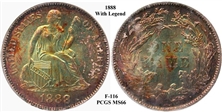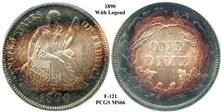GFRC Core Holdings 的钱币相册
Mintage: 682,500 (Both date sizes)
Obverse Dies: 3 Known
The No Stars obverse shows the Christian Gobrecht rendering of the Thomas Sully design, while the reverse has a wreath with ONE DIME, thin long leaves with long stemmed closed berries and the legend UNITED STATES OF AMERICA. All design elements except the date were hubbed into the master die, a technological breakthrough for the time period. First coinage of this group was 30 brilliant proofs struck on June 30, 1837 at the direction of Mint Director, Robert Patterson.
Plate Coin: Fortin 104, Ahwash 2, Small Date, Heavily Clashed Reverse, Original Rose/Blue Toning On Pristine Surfaces. There are two different Small Date obverse dies with one having a heavier punched date than the other. Fortin 104 is the "lighter" Small Date punch. The "heavier" Small Date obverse is sometimes attributed as a Large Date by the grading services so inspection of 1837 Large Date dimes in grading service holders is recommended.
Mintage: 1,992,500
Obverse Dies: 8 Known
Working dies of 1838 through 1840 were created from the No Stars hub of 1837. Each working die had 13 individual stars hand punched resulting in variations in star placement and size. One obverse in 1838 features smaller stars from a punch intended for half dimes and is known as the Small Stars Obverse. The Stars Obverse type was struck at the Philadelphia during 1838 through 1840 and at the New Orleans mint during 1839 and 1840. For the 1838 Philadelphia date, eight different obverse dies have been identified. Many of the obverse dies are found today with important late die states where the die shows large die cracks that tranverse the obverse. The plate coin is the final die state of Obverse 2. This obverse has been paired with three different reverse dies namely, doubled reverse paired with Small Stars Obverse, vertically cracked reverse (Ahwash 3) and the present pairing. During its late die, Obverse 2 exhibits a die crack starting from the rim to the left of the date and progressing through the base and rock and finally ending at LI(B)ERTY. Dealers often refer to this obverse die state as the "unlisted" cracked obverse due to other more significantly cracked obverse dies for this date. The only reverse diagnostic is die roughness between the letters ME in DIME.
Plate Coin: Fortin 104, Even Light Green and Gold Tone, Late Die State But Well Struck
Mintage: 1,992,500
Obverse Dies: 8 Known
Working dies of 1838 through 1840 were created from the No Stars hub of 1837. Each working die had 13 individual stars hand punched resulting in variations in star placement and size. One obverse in 1838 features smaller stars from a punch intended for half dimes and is known as the Small Stars Obverse. The Stars Obverse type was struck at the Philadelphia during 1838 through 1840 and at the New Orleans mint during 1839 and 1840. For the 1838 Philadelphia date, eight different obverse dies have been identified. Many of the obverse dies are found today with important late die states where the die shows large die cracks that tranverse the obverse. The plate coin is the final die state of Obverse 2. This obverse has been paired with three different reverse dies namely, doubled reverse paired with Small Stars Obverse, vertically cracked reverse (Ahwash 3) and the present pairing. During its late die, Obverse 2 exhibits a die crack starting from the rim to the left of the date and progressing through the base and rock and finally ending at LI(B)ERTY. Dealers often refer to this obverse die state as the "unlisted" cracked obverse due to other more significantly cracked obverse dies for this date. The only reverse diagnostic is die roughness between the letters ME in DIME.
Plate Coin: Fortin 104, Even Light Green and Gold Tone, Late Die State But Well Struck
Mintage: 1,323,000
Obverse Dies: 5 Known
A total of five different obverse dies and six reverse dies have been identified for 1839 New Orleans coinage. 1839-O dimes with a Small O mintmark are extremely rare in mint state. The plate coin was puchased at the Heritage pre ANA auction for an amount well above price guide values and is most likely the finest Small O 1839-O dime extant.
Plate Coin: Fortin 101, Small O, The Strike is Needle-Sharp, Every Aspect of Libertys Head, Stars, and all the Obverse Devices are Crisp and Pronounced. On the Reverse, Every Leaf, Letter, and Berry is Bold. Both Obverse and Reverse are Toned a Sunset-Gold at the Periphery, Lighter at the Centers.
Mintage: 1,323,000
Obverse Dies: 5 Known
A total of five different obverse dies and six reverse dies have been identified for 1839 New Orleans coinage. 1839-O dimes with a Small O mintmark are extremely rare in mint state. The plate coin was puchased at the Heritage pre ANA auction for an amount well above price guide values and is most likely the finest Small O 1839-O dime extant.
Plate Coin: Fortin 101, Small O, The Strike is Needle-Sharp, Every Aspect of Libertys Head, Stars, and all the Obverse Devices are Crisp and Pronounced. On the Reverse, Every Leaf, Letter, and Berry is Bold. Both Obverse and Reverse are Toned a Sunset-Gold at the Periphery, Lighter at the Centers.
Mintage: 981,500
Obverse Dies: 8 Known
Eight different obverse dies are known for 1840 No Drapery coinage, including the Chin Whisker variety. Specialist know that Obverse 7 is atypical from other 1840 No Drapery dies due to weaker device and date details. Was Obverse 7 lapped more aggressively than other working dies before employed for coinage production? Reverse G also shows considerable weakness within the devices and could support the explanation of lapping prior to usage.
Plate Coin: Fortin 107, Obverse 7, Previously NGC MS66, Superior Luster with Peripheral Ranges of Rose/Blue Toning, the Reverse Being More Accentuated
Mintage: 1,622,500
Obverse Dies: 8 Known
A total of eight different obverse dies have been identified for 1841 Philadelphia coinage.
The plate coin is an Obverse 3, repunched 184 example which is paired with a second reverse die that is rotated 18 degrees right. Reverse D is perfect during this early die state. I have found rust free reverse die examples to be difficult to locate. Most later die state examples exhibit progressive levels of damage as Reverse D is rusting. The ME in DIME and the UN in UNITED are the prime areas of inspection for determining the level of damage to Reverse D.
Plate Coin: Fortin 104, Repunched 184, Wonderful Rose, Green, Blue and Golden Toning
Mintage: 2,020,000
Obverse Dies: 4 Known
Four obverse dies and potentially five reverse dies have been identified for 1842 New Orleans coinage. The key diagnostic point for Obverse 4 is the die gouge to the left of Liberty's index finger. Tim Cook pointed out the possibility of using this die gouge as an attribution point around 1998. The date placement on Obverse 4 is very similar to Obverse 3, so the die gouge marker is very useful and recommended given the additional die states of this obverse die. Obverse 4 also exhibits a large die blob defect in the right field between Liberty's knee and Star 12. Reverse E features a Medium O mintmark that is positioned right and high. Faint die cracks are just beginning to emerge on the plate coin. I have seen another earlier die state example with no reverse cracks. Both the obverse and reverse are well struck during this die state, unfortunately this does not last long as the dies are polished and subsequently degrade.
Plate Coin: Fortin 105, Medium O, Even Silver Gray Obverse With Light Rose Reverse Toning, Second Finest Graded at PCGS, Well Struck for 1842 O Mint
Mintage: 1,370,000
Obverse Dies: 4 Known
Obverse 3, one of four obverse dies identified to date, exhibits a die crack through base of date digits in later die states. I believe the 1843 obverse die used to strike proof coinage was reused to strike the F-104 die pairing
Plate Coin: F-104, A new gem that is fully brilliant with lively satin-white luster shimmering across both sides.
Mintage: 72,500
Obverse Dies: 2 Known
A historically scarce date but rare during the past 15 years is a result of excessive hoarding. The recent dispersion of the CA hoard has increased availability in grades up through EF45. 1844 dimes are scarce in grades of AU or better with few Mint State examples known. This date, nicknamed the "Little Orphan Annie" dime, has been a favorite target of hoarders throughout its existence.
A single die pair was employed for business strikes while a second die pair was used for proof coinage. On the business strike obverse, die lines are seen on both the lower left and right sides of the reverse. The most significant are located between the rim and UNITED on the left side of the reverse die with additional die lines between rim and the letters ERIC in AMERICA.
Plate Coin: Fortin 102, Even light gray toning over original and problem free surfaces; residual luster is evident throughout. Though graded AU58, this dime is in the condition census for the date.
Mintage: 31,300
Obverse Dies: 2 Known
Only one obverse die (Obverse 1) was used for business strikes while a second obverse is seen on proof coinage. On business strikes, the 6 digit in the date has a defect between the upper loop's ball and the upper section of the lower loop. The space between the crossbar of the 4 digit and the bottom feet is partially filled. Liberty's fingers, on the right hand grasping the pole, are poorly defined. The die area between the toe and adjacent denticle appears to be defective. Die chips are found around all stars with Stars 3, 4, 5, 6 and 13 exhibiting the boldest die chips. The date on business strikes is level while on proofs (Obverse 2), the date slopes downward. Ahwash indicates that Reverse A has repunching in the legend with die cracks from the rim to the tops of (A)ME(R)I(CA). A close inspection of the plate coin revealed the presence of die lines from the tops of (A)ME(R)ICA to the rim.
Plate Coin: Fortin 101, Condition Census Example, Proof Like Surfaces and Well Struck, A Choice Example of the Elusive 1846 Date In High Grade
Mintage: 245,000
Obverse Dies: 3 Known
High grade 1847 examples are typically well struck with nearly full heads. The three 1847 varieties are popular due to their inclusion in the Ahwash encyclopedia.
Plate Coin: Fortin 102, Ahwash 2, All Digits Touch Base, Light Gray and Brown Obverse Toning, Increased Rose Toning On Reverse, Very Well Struck
Mintage: 300,000
Obverse Dies: 3 Known
In problem free EF or better, 1849-O dimes are difficult to locate. Mint State specimens are available but at a significant premium to later New Orleans Mint State dimes from 1850 through 1852. Large O examples are nearly always weakly struck on obverse and reverse. Finding a fully struck Large O dime will be very challenging and could take many years. Small O Varieties 102 and 104 are the most likely to be found well struck. Three obverse dies and two reverse dies were used to produce the 1849 New Orleans coinage.
Plate Coin: Fortin 101b, Large O Reverse With Die Cracks, Incredible Toning Throughout and a Bold Strike for Large O Coinage, Simply One of the Finest 1849-O Examples Seen
Mintage: 1,931,500
Obverse Dies: 8 Known
For the 1850 Philapelphia date, eight obverse and nine reverse dies have been identified. Obverse 2, on the registry coin, is easy to attribute through its very high date and the 185 digits touching the base. Reverse C has heavy die flash around bow loops and knot.
Plate Coin: Fortin 103, Pittman Collection, Ahwash 3, Golden and Blue Toning Over Prooflike Surfaces, A Fine PQ Example
Mintage: 1,026,500
Obverse Dies: 6 Known
A total of six obverse and seven reverse dies have been cataloged for 1851 Philadelphia coinage. This is a difficult date to research for varieties due to limited movement in the date placement. Most examples are well struck and do not show significant die cracks. Three different repunched obverse dies are known.
Plate Coin: Fortin 102, Repunched First 1 Digit, Outstanding Silver Gray with Iridescent Toning Accents on the Obverse and Reverse. Sharply Struck with Full Stars, Strong Head Details, and Bold Branches.
Mintage: 4,470,000
Obverse Dies: 11 Known
Both the date and arrows were placed on the master hub for 1854 dimes resulting in a consistent positioning of these devices on the obverse die. Variations in date hubbing strength on the working dies produced strong and weak date transfers.
Plate Coin: Lightly Gold Toned Gem Example
Mintage: 2,075,000
Obverse Dies; 8 Known
Both the date and arrows were placed on the master hub for 1855 dimes resulting in a consistent positioning of these devices on the obverse die. Variations in date hubbing strength on the working dies produced strong and weak date transfers. The working die preparation process produced at least three 1855 obverse dies with doubling in the date or shield. 1855 dimes are much more difficult to find sharply struck than their 1853 or 1854 With Arrows counterparts.
Plate Coin: Fortin 101a, Obverse Die Used For Proof Strikes, Satiny Luster on Both the Obverse and Reverse of This Near-Gem. The Strike is Sharp and the Surfaces are Problem Free. Lightly Patinated in Golden-Gray Hues
Mintage: 1,540,000
Obverse Dies: 5 Known
1857 New Orleans coinage is found with Large and Medium reverses. The Medium O is moderately scarcer than the Large O in circulated grades and is very scarce in Mint State. The Large O is more available in Mint State.
Five obverse dies and six reverse dies have been identified for 1857 New Orleans coinage.
Plate Coin: Fortin 101a, A Sharp and Gorgeous Gem with Rich Underlying Lustre Supporting a Wealth of Peach, Gold, and Pale Rose Iridescence Tone.
Mintage: 1,884,000 (Both obverse types)
Obverse Dies Type I: 7 Known
Obverse Dies Type II: 11 Known
In 1861, Longacre changed the obverse hub to improve striking quality. During that year, obverse dies were produced from both the Type I and Type II obverse hubs. The old hub (Type I) of 1861 has 5 vertical lines in the upper part of the shield above the banner. Liberty's index finger also fell on the outside of the left shield edge. On the new hub (Type II) of 1861, there are 6 vertical lines above the banner. Liberty's
index finger points straight down along the left edge of the shield. The letters on the Type I hub are thinner than the letters on the Type II hub.
Die variety research has revealed that the mint used eleven Type II obverse dies vs. six Type I obverse dies or about a 2:1 ratio. This observation supports the fact that Type II 1861 dimes are easier to locate than their Type I counterparts.
Plate Coin: Fortin 106, Type II Obverse, Wonderfully original and richly toned, both sides are veiled in a blend of copper-rose, cobalt-blue and olive-gold colors that are a bit more vivid on the reverse. Highly lustrous with a well-frosted texture
Mintage: 847,550
Obverse Dies: 8 Known
Nearly all 1862 dimes come well struck. Many examples are found with prooflike surfaces. To date, eight different obverse dies have been identified for Philadelphia coinage.
Plate Coin: Fortin 102a, Business Strike From Proof Dies, Strictly Original As Expected With MS66 Grade, Medium Gray/Rose/Lavender Toning Over Soft Luster
Mintage: 157,500
Obverse Dies: 1 Known
Strike weakness is common for 1863 San Francisco coinage. Examples are often seen with a flat head and weakness in the letters (OF AME)RICA. Reverse weakness will be found on the bow knot and lower wreath. Only one die pair is known.
Scarce in all circulated grades and becomes difficult in problem free EF-AU. Another San Francisco mint date that is rare in Mint State.
Plate Coin: Fortin 101, A Silky, Satiny Specimen With Intense Cartwheel Luster. Faint Sky Blue, Gold and Rose Toning, Well Struck Throughout. Formerly in the Frog Run, Lovejoy and Reed Hawn Collections
Mintage: 10,500
Obverse Dies: 2 Known
Two sets of dies were used to strike 1865 Philadelphia coinage. This date comes well struck when it can be located. Business strikes are currently in strong demand and are difficult to locate.
The two 1865 die pairs will be found in progressive die states and have produced interesting varieties. The first pair (Obverse 1/Reverse A) was thought to have been used for both proof and business strike coinage by Ahwash, however I have only seen business strikes from these dies. The die pair becomes heavily clashed during its end of life for business strikes. The second die pair (Obverse 2/Reverse B) was though to have also produced both proofs and business strikes by Ahwash. However, I have only seen proofs from this die pair, with a spectacular 180 degree rotated reverse variety being known for the die pair.
Plate Coin: Fortin 101a, Repunched Date, Condition Census, Wonderful Luster and Cameo Effect
Mintage: 260,000
Obverse Dies: 1 Known
A single die pair was used for 1868 San Francisco coinage. This date is scarce in the lower circulated grade and becomes very scarce in EF-AU, rare in Mint State and presently underrated in CoinValues.
For years a separate doubled reverse die was listed by Breen and Greer. In 2005, research revealed that the doubled reverse die was caused by strike doubling and not die doubling via a shifted second hubbing of the reverse die.
Plate Coin: Fortin 101, Fully Struck and Lustrous, High End PQ Is Best Way To Describe This Rare Date In Mint State. Purchased in an ICG MS65 Holder.
Mintage: 907,710
Obverse Dies: 13 Known
To date, thirteen obverse dies have been documented for 1871 Philadelphia coinage. A relatively common date in lower grades that becomes scarce in EF or better. This date is very scarce in Mint State and has proven to be elusive during the past few years.
Plate Coin: Fortin 109, Well Struck, White and Lustrous
Mintage: 2,378,500
Obverse Dies: 23 Known
A common date in all grades except Mint State. 1873 With Arrows Mint State examples are more difficult to locate than their 1874 With Arrows counterpart. To date, twenty-three obverse dies have been identified after years of diligent searching.
Plate Coin: Fortin 104, Repunched 1, Traces of Repunching Are Visible Above the Left and Right Bases of the 1 Digit. Soft Light Gray Tone Throughout, Well Struck
Mintage: 240,000
Obverse Dies: 2 Known
Two sets of obverse and reverse dies were employed for 1874 San Francisco coinage. The reverse dies are identified as Small Thin S and Micro S due to the mintmark shape and sizes.
The strike quality of the 1874 San Francisco dimes is much poorer than Philadelphia examples. Both the Small Thin S and Micro S varieties (when it can be located) are often seen with uneven strikes and weakness in Liberty's head. Strike weakness can be acute on Small Thin S reverses.
Plate Coin: Fortin 101, Micro S, A Gem Example with Even Bronze Toning Highlighting a Full Struck Throughout, CAC Certified
Mintage: 4,645,000 (both In and Below Wreath Varieties)
Obverse Dies: 10 In Wreath and 7 Below Wreath Known
1875 Carson City dimes will be found with the CC mintmark "In the Wreath" and "Below the Wreath". A common date and variety in all grades. The In Wreath variety is much more available than the Below Wreath variety though the Below Wreath is still fairly common in the lower circulated grades.
Plate Coin: Fortin 106, CC Mintmark In Wreath, Light Blue and Rose Toning Over Magnificent Surfaces, Wonderful Gem in Second Generation PCGS Holder
Mintage: 7,700,000
Obverse Dies: 7 Known With Type I Reverse and 14 Known With Type II Reverse
1877 Carson City dimes are common in all grades including Mint State. The Type I Reverse is slightly scarcer than Type II Reverse examples, however the Type I reverse is still fairly common and straightforward to locate. The number of known obverse dies paired with Type II reverse dies will continue to increase as more research occurs.
Plate Coin: Type II Reverse, Fortin 109, The 77 digit in the date are lightly repunched. A wonderful Carson City Seated dime that has vibrant luster and a bold strike. The tan-gold and cream-gray fields and devices are framed by rich peripheral sea-green patina. What a lovely additional to the PCGS registry set after years of waiting for a beautifully toned example.
Mintage: 1,678,000
Obverse Dies: 4 Known With Type I Reverse and 10 Known With Type II Reverse
1878 Philadelphia dimes are considered a tougher "common" date to locate. The Type I reverse variety is very scarce in all grades including a R6 designation in Mint State. Examples of 1878 dimes with a Type I reverse should command a premium. In general, nice higher grade 1878 dimes are currently underrated when valued at common date pricing.
Plate Coin: Fortin 103, Type I Reverse, Well Struck Even Light Gold Toning Throughout
Mintage: 15,100
Obverse Dies: 5 Known
Despite its low mintage, 1879 Philadelphia dimes are readily available in Mint State and scarce in circulated grades. Surprisingly, five obverse dies were used to strike a very limited amount of coinage. One of the five obverse dies was discovered in 2005.
Plate Coin: Fortin 105, Die Pair Variety Identified In 2005, A Mauve-Golden Specimen that Offers Satin Reflection and Bold Definition of Design Elements, Ex. Lemus Collection
Mintage: 3,366,380
Obverse Dies: 11 Known
1884 San Francisco dimes are common date in all grades, finding well struck examples in higher grades could be challenging. Most reverse dies are seen with die cracks. Weakness in the reverse denomination is common. Another common Seated Dime date that needs incremental study to complete the task of identifying the obverse dies.
Plate Coin: Simply a Gem! Incredible Original Patina With Lavendar, Rose, Blue Toning On Obverse and Light Sunset Gold and Blues on Reverse, a Remarkable Dime That Should be in a MS67 Holder
Mintage: 6,377,570
Obverse Dies: 18 Known
The 1886 Philadelphia date offers a significant number of repunched date varieties. None of the repunched varieties are considered rare. Once again, this is a common date that needs further research given its sizable mintage.
Plate Coin: Fortin-119, Minor misplaced 8 digit in gown, 100% toned and wholly original with a superb strike, nice frost and excellent eye-appeal. Both obverse and reverse are toned in shades of green, plum and pale blue-green and are exceptionally clean.
Mintage: 11,283,939
Obverse Dies: 14 Known
This date is very common and currently plentiful in MS63 through MS65 grades due to a recent hoard. However, it becomes more difficult in MS66 and rare In MS67 grades.
The task of researching and cataloguing the obverse dies is overwelming for the 1887 date due to the very high mintage. At least 60 obverse dies are possible.
Plate Coin: Light to Moderator Rose and Gold Toning On Both Obverse And Reverse.
Mintage: 5,496,487
Obverse Dies: 19 Known
The 1888 Philadelphia coinage presents a host of varieties for the Seated Dime specialist. Three proof dies have been identified along with four significant misplaced dates. In addition, two repunched date varieties and a polished reverse die with multiple die pairings are available.
Plate Coin: Fortin 116, Consistant Vibrant Luster Beneath Bold Blue-green, Peach, and Lemon-gold Patina on both Obverse and Reverse. A Simply Amazing Seated Dime...
Mintage; 9,911,541
Obverse Dies: 21 Known
A common date in all grades including Mint State. Much incremental research is required to determine the full extent of repunched dates and misplaced date varieties.
Plate Coin: Fortin 121, Lustrous Silver Centers Turning to Golden Rose and then Aquamarine Bullseye Toning
